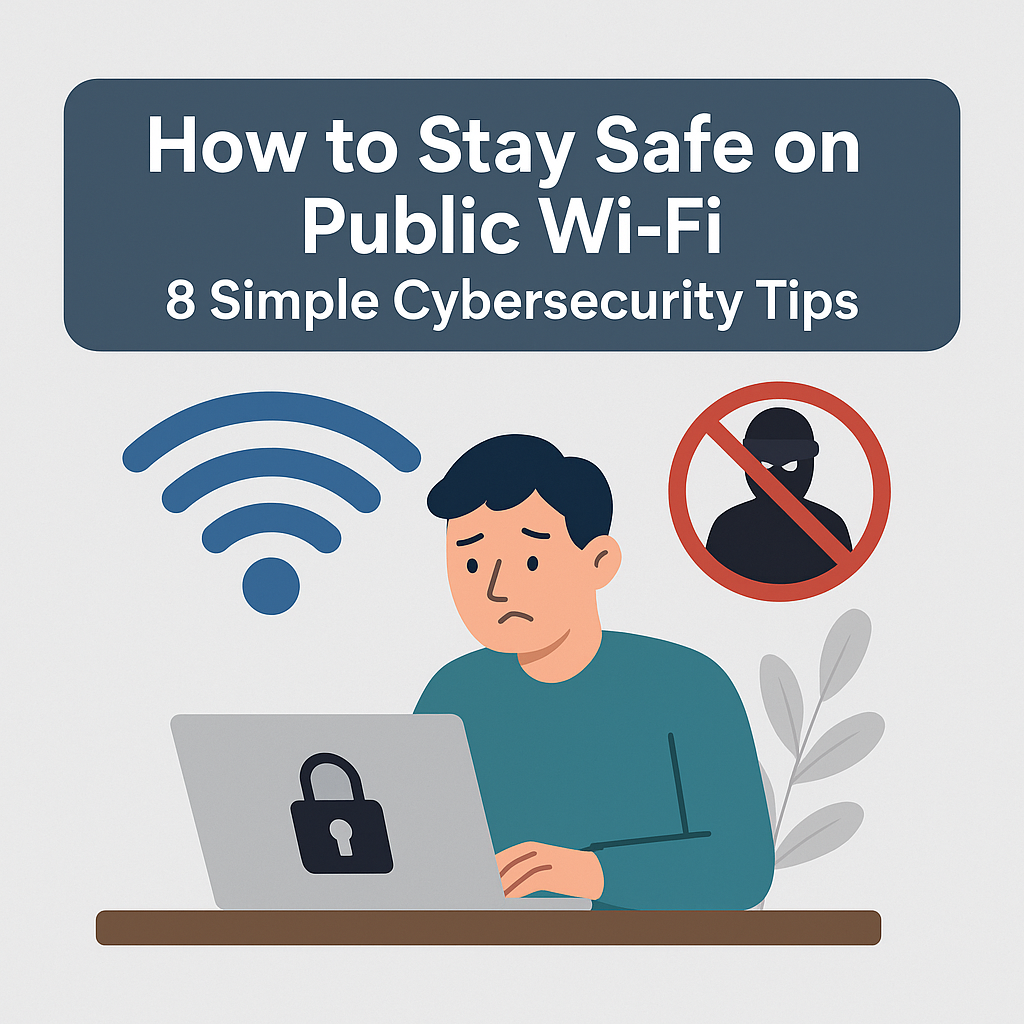How to Stay Safe on Public Wi-Fi: 8 Simple Cybersecurity Tips
Learn how to protect your data on public Wi-Fi with easy-to-follow cybersecurity tips anyone can use at cafés, airports, and hotels.

Public Wi-Fi is convenient, but also dangerous if you don’t take precautions. Whether you’re at a café, airport, hotel, or mall, connecting to public Wi-Fi can expose your personal data to cybercriminals.
In this guide, we’ll explain how to stay safe on public Wi-Fi with 8 easy cybersecurity tips that anyone can follow, with no tech expertise needed.
🔎 Why Is Public Wi-Fi Unsafe?
Public Wi-Fi networks often lack encryption and security protocols. This makes it easy for hackers to:
Eavesdrop on your internet traffic (known as “packet sniffing”)
Set up fake Wi-Fi networks (e.g. “Free_Airport_WiFi”) to steal your data
Inject malware into your device without your knowledge
If you use public Wi-Fi without protection, your passwords, banking details, emails, and even private photos could be at risk.
✅ 1. Use a VPN to Secure Your Connection
A VPN (Virtual Private Network) encrypts your internet traffic, making it unreadable to hackers.
📌 Tip: Use trusted VPNs like NordVPN, ProtonVPN, or Surfshark.
Why it helps: Even on a compromised network, a VPN creates a secure tunnel between your device and the websites you visit.
✅ 2. Avoid Accessing Sensitive Accounts
Do not log in to banking apps, work emails, or government portals on public Wi-Fi.
Why it helps: These accounts hold sensitive data. Wait until you’re on a trusted connection.
✅ 3. Check for HTTPS Before You Browse
Always ensure websites begin with https://. The “S” stands for secure. It encrypts your data during transmission.
🔐 Install the free HTTPS Everywhere extension on Chrome or Firefox for extra protection
✅ 4. Disable Auto-Connect to Wi-Fi
Your device may auto-connect to unsafe networks without warning.
How to fix it:
On iPhone: Settings > Wi-Fi > Disable Auto-Join
On Android: Settings > Network & Internet > Wi-Fi Preferences
On Windows/Mac: Turn off “connect automatically” for public networks
✅ 5. Turn Off File Sharing and Bluetooth
Disable these features unless you’re actively using them.
Why it helps: File sharing and Bluetooth can be exploited to access your device remotely.
✅ 6. Use Two-Factor Authentication (2FA)
Enable 2FA on all accounts — especially email, banking, and social media.
Apps to try:
Google Authenticator
Authy
Microsoft Authenticator
Why it helps: Even if someone steals your password, they won’t be able to log in without your secondary code.
✅ 7. Keep Your Device and Apps Updated
Updates often include patches for security vulnerabilities.
Make sure your phone, laptop, browser, and apps are always updated before connecting to public Wi-Fi.
✅ 8. Turn Wi-Fi Off When Not in Use
Disconnect from public Wi-Fi when you’re done browsing.
Why it helps: Reduces the risk of background data leaks or reconnection to unsafe networks.
⚠️ Real-World Example: Why This Matters
A business traveler at an airport connected to a fake network. Hackers stole his email login and tricked his assistant into wiring $100,000.
All of this happened in less than 5 minutes.
📋 Recap: How to Stay Safe on Public Wi-Fi
Use a VPN
Avoid sensitive logins
Only browse HTTPS sites
Disable auto-connect
Turn off file sharing and Bluetooth
Use 2FA
Keep devices updated
Disconnect when not in use
🛡️ Stay Protected with Let’s Think Wireless
At Let’s Think Wireless, we help individuals and businesses protect themselves from online threats — whether at home, at work, or on the go.
Need help securing your phone, laptop, or business network?
Book a free cybersecurity consultation today.
📞 Call or WhatsApp: +1-868-461-3253
